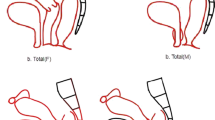Abstract
Background
Exenteration surgery for multi-visceral pelvic malignancy is a complex life-changing operation with high perioperative morbidity and mortality. Traditional open surgery has long been the standard approach for pelvic exenteration for achieving Ro resection which is the main aim of surgery. In the current era of minimally invasive surgery, robotic-assisted pelvic exenteration has provided a promising alternative, offering potential advantages in terms of improved oncological outcomes and enhanced postoperative recovery. This study aims to explore the feasibility of a robotic platform for locally advanced multi-visceral pelvic malignancy.
Methods
A retrospective review from the prospectively maintained robotic colorectal surgery database at University Hospital Coventry and Warwickshire (UHCW) Trust was performed. Demographic details and clinical and surgical details were documented from the case records. Data was analysed using SPSS version 22.
Results
Thirteen female patients diagnosed with primary or recurrent pelvic malignancy who underwent robotic pelvic exenteration at UHCW between February 2019 and April 2023 at UHCW were included. The mean age of our patients was 60.4 (± 10.1) years. Complete Ro resection was achieved in all 13 (100%) cases on final histopathology. The median length of hospital stay was 15 days after this extensive surgery. Grade 3 morbidity on Clavien–Dindo classification was observed in four (30.7%) patients, while zero percent 30-day mortality was experienced in this study. At a median follow-up of 21 (3–53) months, we observed tumor recurrence in three (23.7%) patients, while death in four (30.7%) patients. Only few studies have highlighted outcomes of robotic pelvic exenteration, and our results were quite comparable to them.
Conclusion
Robotic-assisted pelvic exenteration for primary or recurrent pelvic malignancy is feasible with improved oncological and acceptable postoperative outcomes.


Similar content being viewed by others
Abbreviations
- ASA :
-
American Society of Anesthesiologists
- DS :
-
Disease-free survival
- OS :
-
Overall survival
- MDT :
-
Multidisciplinary meeting
- SPSS :
-
Statistical Package for the Social Sciences
- UHCW :
-
University Hospital Coventry and Warwickshire
References
Butcher HR Jr, Spjut HJ (1959) An evaluation of pelvic exenteration for advanced carcinoma of the lower colon. Cancer 12(4):681–687
Shin US, Nancy You Y, Nguyen AT, Bednarski BK, Messick C, Maru DM et al (2016) Oncologic outcomes of extended robotic resection for rectal cancer. Ann Surg Oncol 23:2249–2257
Temple WJ, Ketcham AS (1982) The closure of large pelvic defects by extended compound tensor fascia lata and inferior gluteal myocutaneous flaps. Am J Clin Oncol 5(6):573–578
PelvEx Collaborative (2019) Changing outcomes following pelvic exenteration for locally advanced and recurrent rectal cancer. BJS Open 3(4):516–520. https://doi.org/10.1002/bjs5.50153
Saqib SU, Raza MZ, Evans C, Bajwa AA (2023) The robotic learning curve for a newly appointed colorectal surgeon. J Robot Surg 17(1):73–78
Chang TP, Chok AY, Tan D, Rogers A, Rasheed S, Tekkis P et al (2021) The emerging role of robotics in pelvic exenteration surgery for locally advanced rectal cancer: a narrative review. J Clin Med 10(7):1518
Nanayakkara P, Ahmed S, Oudit D, O’Dwyer S, Selvasekar C (2014) Robotic assisted minimally invasive pelvic exenteration in advanced rectal cancer: review and case report. J Robot Surg 8:173–175
Steele SR, Maykel JA, Lightner AL, Bleier JI (2022) Steele’s colon and rectal surgery. In: Multivisceral and management of recurrent colorectal cancer. Wolters Kluwer Health, p 460
Guru KA, Nogueira M, Piacente P, Nyquist J, Mohler JL, Kim HL (2007) Rapid communication: robot-assisted anterior exenteration: technique and initial series. J Endourol 21(6):633–639
Lim PC (2009) Robotic assisted total pelvic exenteration: a case report. Gynecol Oncol 115(2):310–311
Shin J, Kim J, Kwak J, Hara M, Cheon J, Kang S et al (2014) First report: robotic pelvic exenteration for locally advanced rectal cancer. Colorectal Dis 16(1):O9–O14
Williams M, Perera M, Nouhaud F-X, Coughlin G (2021) Robotic pelvic exenteration and extended pelvic resections for locally advanced or synchronous rectal and urological malignancy. Investig Clin Urol 62(1):111
Kroon HM, Dudi-Venkata N, Bedrikovetski S, Thomas M, Kelly M, Aalbers A et al (2019) Palliative pelvic exenteration: a systematic review of patient-centered outcomes. Eur J Surg Oncol 45(10):1787–1795
Quyn AJ, Solomon MJ, Lee PM, Badgery-Parker T, Masya LM, Young JM (2016) Palliative pelvic exenteration: clinical outcomes and quality of life. Dis Colon Rectum 59(11):1005–1010
Larach JT, Flynn J, Fernando D, Mohan H, Rajkomar A, Waters PS et al (2022) Robotic beyond total mesorectal excision surgery for primary and recurrent pelvic malignancy: feasibility and short-term outcomes. Colorectal Dis 24(7):821–827
Author information
Authors and Affiliations
Contributions
All authors contributed to the study’s conception and design. Material preparation, data collection, and analysis were performed by S.S. and Z.R. Data analysis was performed by S.S. The first draft of the manuscript was written by S.S., later amended by Z.R. J.T., O.A., and A.B. were robotic surgeons involved in care of patients and did the final editing. All authors commented on previous versions of the manuscript. All authors read and approved the final manuscript.
Corresponding author
Ethics declarations
Ethical approval
Not required as data was collected from files and patients were not directly involved.
Competing interests
The authors declare no competing interests.
Additional information
Publisher's Note
Springer Nature remains neutral with regard to jurisdictional claims in published maps and institutional affiliations.
Rights and permissions
Springer Nature or its licensor (e.g. a society or other partner) holds exclusive rights to this article under a publishing agreement with the author(s) or other rightsholder(s); author self-archiving of the accepted manuscript version of this article is solely governed by the terms of such publishing agreement and applicable law.
About this article
Cite this article
Saqib, S.U., Raza, M.Z., Twigg, J. et al. Feasibility of robotic platform to perform R0 resection for locally advanced multi-visceral pelvic malignancy: an institutional experience on outcomes of robotic pelvic exenteration. Langenbecks Arch Surg 409, 9 (2024). https://doi.org/10.1007/s00423-023-03206-7
Received:
Accepted:
Published:
DOI: https://doi.org/10.1007/s00423-023-03206-7




